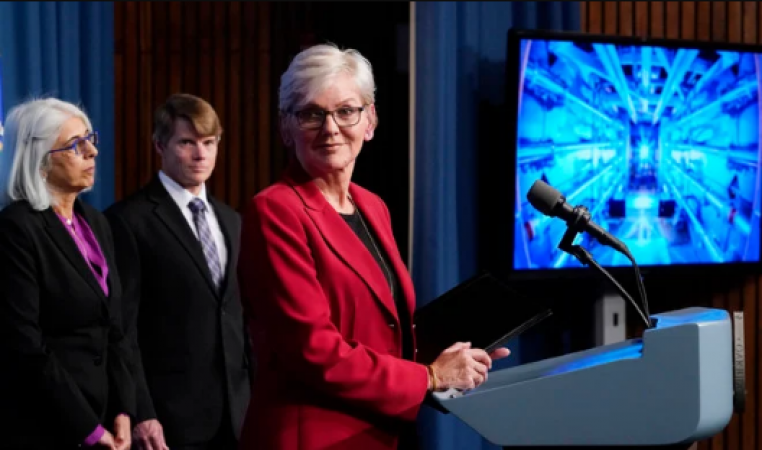
Washington: Researchers revealed on Tuesday that they have successfully generated more energy from a fusion reaction than was needed to ignite it. It represents a significant advance in a long-standing effort to harness the Sun's energy-generating process.
The result was discovered last week by scientists at the Lawrence Livermore National Laboratory in California, according to the Department of Energy. The objective, known as net energy gain, has proved elusive because it is extremely challenging to control fusion, which occurs at extremely high temperatures and pressures.
Energy Secretary Jennifer Granholm and other officials said the development would open the door to improvements in both the future of clean energy and the development of national defense.
Also Read: Daughter saw her obscene photos in father's laptop, took this terrible step
At a news conference in Washington, Granholm said, "Ignition allows us for the first time to replicate certain conditions that are found only in stars and the Sun. This achievement allows us to power our society with zero-carbon energy." gives." "Brings. Fusion Energy."
According to Granholm, the discovery of fusion ignition is "one of the most impressive scientific feats of the 21st century," and it "will be written in the history books."
White House science adviser Aarti Prabhakar appeared with Granholm and called the fusion ignition achieved on 5 December "an engineering marvel beyond belief" and "a tremendous example of what persistence can really achieve".
Fusion proponents believe that one day it will replace traditional energy sources such as fossil fuels. Fusion is still decades away from providing carbon-free energy to homes and businesses. However, experts claimed that the announcement represented a significant advance.
Professor Dennis Whyte, director of the Massachusetts Institute of Technology's Plasma Science and Fusion Center and a pioneer in fusion research, described the event as "almost like a starting gun going off". To combat climate change and ensure energy security, we must advance the development of fusion energy systems.
According to Livermore Lab director Kim Badil, despite "very significant obstacles", fusion technology is likely to be widely used in "a few decades", not the 50 or 60 years predicted earlier.
Also Read: Scientists report that 2 volcanoes in Hawaii have stopped erupting
By exerting such pressure on neighboring hydrogen atoms that they collide to form helium, fusion produces enormous amounts of heat and energy. Unlike other nuclear reactions, it does not produce radioactive waste.
The achievement was cited by President Joe Biden as evidence of the need to keep funding research and development. He said at the time, "Look what the Department of Energy is doing on the nuclear front. There's a lot of good news coming out."
Fusion research has cost billions of dollars and taken decades to complete, but the results have been exciting for a short time.
Prior to the breakthrough, scientists at Lawrence Livermore's National Ignition Facility had used 192 lasers and temperatures many times hotter than the center of the Sun to generate an incredibly brief fusion reaction.
The laser focused an enormous amount of heat onto a small spherical capsule, said Marvin Adams, deputy administrator of the National Nuclear Security Administration, a division of the Department of Energy.
The result was a superheated plasma environment where a reaction produced approximately 1.5 times more energy than light.
There is a long road to go before the net energy gains translate into sustainable electricity, says Ricardo Betti, a professor and laser fusion expert at the University of Rochester.
He compared the discovery to the first time people realized that turning oil into gasoline and igniting it could cause an explosion. According to Betty, both the engine and the tires are still missing. "You can't claim to own a car.
The power used to power the lasers and run the project as a whole was not included in the net energy gain achievement because it only applied to the fusion reaction. To be practical, fusion would need to generate significantly more power and for longer durations.
Livermore Lab, also known as LLNL, is sometimes described as "lasers, lasers, nothing but lasers," according to Budil. But she said the lab's motto, "Science and Technology on a Mission," "reflects our approach well."
Manipulating the physics of stars is very challenging. According to Whyte, the fuel must be hotter than the center of the Sun. the fuel wants to get out and cool down; It doesn't want to be hot. It is difficult to stop it, he said.
According to Jeremy Chittenden, professor of plasma physics at Imperial College, London, the results from the California lab exceeded expectations.
Also Read: Denial of bail for FTX founder Bankman-Fried may increase the likelihood of detainment
Despite the fact that there is still much work to be done before fusion can be used as a source of power, Chittenden expressed hope that it will eventually become "the ideal power source that we thought it would be"—a source of energy that emits no carbon and runs on a plentiful form of hydrogen that can be extracted from seawater.
One method of fusion involves converting hydrogen into plasma, an electrically charged gas that is then managed by massive magnets. The International Thermonuclear Experimental Reactor, a 35-nation collaboration, researchers at the Massachusetts Institute of Technology, and a private company are all investigating this technique in France.
The teams working on those projects on two continents announced notable developments in the essential magnets required for their work last year.
Professor of experimental plasma physics at the University of Michigan, Carolyn Kuranz, hoped the finding would spur "increased interest and vigour" in fusion research, including from business, which she and others said will be necessary to bring fusion energy to the grid.
We'll need to use a variety of energy production options if we're going to stop further climate change, according to Kuranz. And nuclear energy, including both fission and fusion, really needs to be considered in this process. Renewable energy sources won't get us there by themselves.